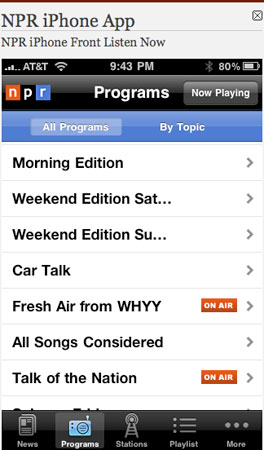Convergence Aesthetics: Design for Mobile Attention, by Eduardo Navas

Image source: paidcontent.org
The pervasiveness of the screen in mobile media is pushing convergence development in two particular ways worth noting. The first, how image and text are increasingly treated the same by users, is actually a stepping stone to the second, which is how the convergence (combination) of all media is designed not only to provide the greatest access to as much information as possible, but also to negotiate which material is likely to be noticed first.
In relation to this, NPR recently released an iPhone widget that enables users to download a podcast or listen to live streaming. This particular widget is designed to complement multitasking, as NPR’s Digital SVP & GM Kinsey Wilson explains to Paid Content:
The small television in the kitchen comes to mind when reading Wilson’s explanation: people for the most part listen to the news while getting ready to leave for work in the early morning, or in the evening while preparing dinner. From time to time, when something of interest comes up, people are likely to look up and pay attention to the screen. In this case, the television is used as a radio with visual options. However, as it is obvious, the Television was not initially designed for this function.
The NPR Widget follows this line of thinking. But most importantly, the application acknowledges a tendency that is already quite common: to treat sound, text and any other media the same for the sake of content delivery. In this regard, iPhone users are likely to access online material from different places throughout the day. At times they might be on the subway, at others in the office. In any case, text or sound could best fit their particular situation as Wilson notes. NPR’s widget may well be an experiment that encourages users to keep doing what they already do with simultaneous use of two or three different applications, only here they can do it with one which literally mashes up text and sound at the will of the user, but unlike a typical mashup, the particular media is presented as an either/or option (though the user could read while listening).
This shift is important for the real motivation behind the development of the widget, which is to find innovative ways to create awareness of content beyond the top rated material. Again from Paid Content:
While the economics of the Long Tail (that of having material available for as many niche markets as possible) has proven to have great potential for the development of media, the truth is that one could potentially search for anything, yet one is likely to stick to the first hits if one is not sure what to look for. Along these lines, NPR opted to offer upfront links to what they know most people will likely listen, which also happens to be NPR content. This is not so different from having the best sellers and recent releases available on the bookshelves at any major book store chain.
But one should wonder if just as NPR is able to offer the same content in the format of sound or text for the users’ convenience, widgets could be developed (past an experimental phase) that make accessible material beyond the top hits. At the moment, even with a powerful search engine, people are likely to stick to the “head” of the available content. If online resources are concerned with recycling content from the past, to make it just as relevant as their recent material, this is an issue that should be evaluated, and should also be extended to how material is accessed through RSS readers.








